Home Hi-Tech Android World ,,,,,For some time we have been looking for a system with microphone inputs able to function as an accompaniment instrument for music evenings with friends both at home and outside: the characteristics we were looking for were: lightness, discrete power, the possibility of mixing voice and music and above all autonomy and portability.
On the market there are many portable and autonomous solutions for Karaoke, accompaniment, PA and teaching accompanied by music, some in “caddy” format, others in boombox format and others designed for “cantatu” use with lights and lights and CD player. The Aukey system we tested seems to go to the point: a subwoofer that takes the entirety of the rear section of the large “tube” and a front that carries the two tweeters, the bass reflex duct and the control electronics with inputs and display. The external surface of the cylinder is completely smooth and carries only the two foldable handles that will be used for transport. But let's get to unboxing.

The packaging
Aukey's system is contained in Aukey's classic cardboard box that pays little attention to aesthetics: the product is schematically depicted on one side with the specifications on the opposite side. Aukey sells on Amazon and does not need to display their boxes in a shop window.
Inside we find the large cylinder held in place by two shaped blocks of foam, the microphone with a cable of good length, a mini jack-mini jack cable to connect an external device and the power cable with a coaxial socket that ends in a classic USB plug. To complete the whole, a booklet in 5 languages including Italian.
It should be noted that there is no power supply inside: just use any Aukey or third party 5Volt / 1Ampere power supply with USB socket. Virtually any recent smartphone power supply will be able to charge the speaker.
We are talking about recharging because one of the main features of the system is that of being equipped with a 5200 mAh battery that allows it to work for more than 8 hours (tested with different connected systems – the plate autonomy is 8 and a half hours and we never went very far)
 The big box gives little to the color
The big box gives little to the color  The features on the bottom
The features on the bottom  The big boxed cylinder
The big boxed cylinder  We release it along with the rest of the content
We release it along with the rest of the content  Here the cylinder and accessories
Here the cylinder and accessories 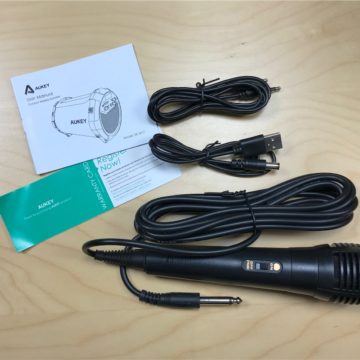 Jack, USB power cable, audio cable
Jack, USB power cable, audio cable 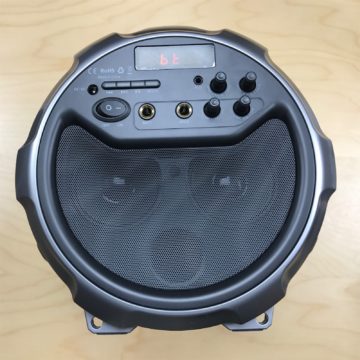 As soon as it is switched on, it prepares for bluetooth synchronization. Note the two speakers side by side and the hole for the bass reflex. The woofer is on the other side
As soon as it is switched on, it prepares for bluetooth synchronization. Note the two speakers side by side and the hole for the bass reflex. The woofer is on the other side 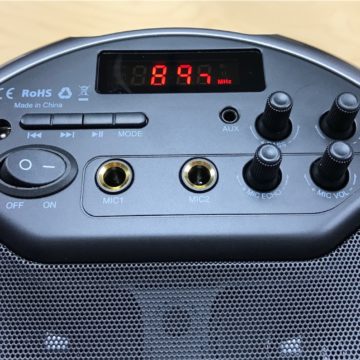 Connectors and potentiometers in the foreground. Here we are on FM tuning on the display.
Connectors and potentiometers in the foreground. Here we are on FM tuning on the display. 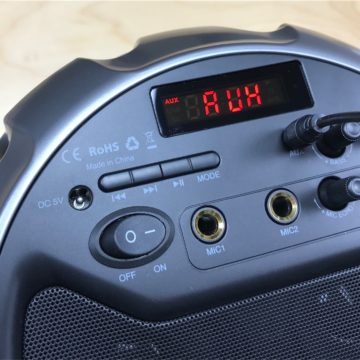 Here we have selected the Aux input
Here we have selected the Aux input 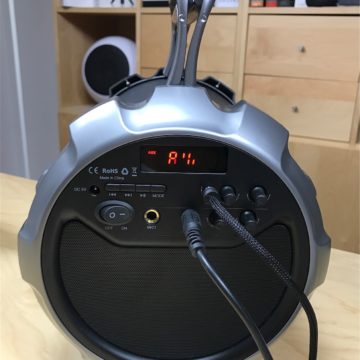 Microphone and aux cable connected and the “wing” handles “Raised
Microphone and aux cable connected and the “wing” handles “Raised 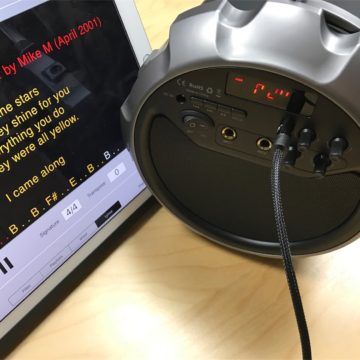 Here we use iPad Pro 12.7 as a source and display for Karaoke
Here we use iPad Pro 12.7 as a source and display for Karaoke 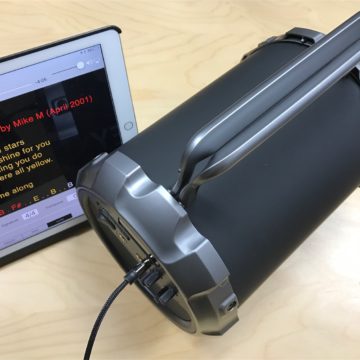 A view from above
A view from above 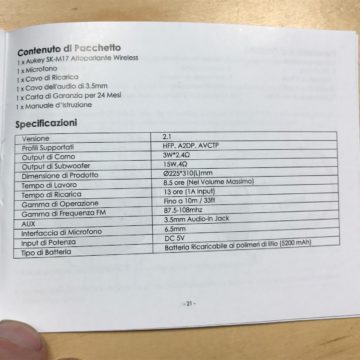 The specifications in Italian
The specifications in Italian  Indications on connectors and buttons
Indications on connectors and buttons  How to synchronize Bluetooth (but we only work with Android)
How to synchronize Bluetooth (but we only work with Android)
Connections, controls and modes for music
As we have seen, all the inputs and adjustments are on one side and we find in order, under the red LED display, the power input, the 4 forward and back control buttons, play / pause and the tato mode and then continuing the mini jack auxiliary input, the potentiometer for adjusting the bass and the general volume and then under the on / off switch, the two microphone inputs with full size Jack, the potentiometer for the echo on the microphone inputs and the relative volume.
The Mode key allows you to activate three different modes: the starting one is the bluetooth which with two beeps makes known its possibility of activation, the FM which activates the radio and finally the AUX which activates the auxiliary input.
Bluetooth is version 2.1 and is the most critical feature of this speaker if not the only really critical one since it does not work in any way with iOS devices or with the Mac: we have tried in all ways, positions, shutdowns and activations and with all versions of the operating system but there was nothing to do with the wireless connection which self-deactivated. On the other hand, no problem with various android systems, phones, projectors and Android TVs, once the wireless connection was activated on the external element, the Aukey system responded with 3 beeps to confirm the connection, also stable.
Obviously, for those who have an iPhone, an iPad or a Mac the solution is to use the economical cable supplied with Aukey Speaker or a cable of superior section and quality. The aux cable also works as an FM antenna and increases the tuning capacity of the stations that are searchable with the keys below the display.
How do the potentiometers work? The volume acts on the general level of speakers and music while “Mic Vol” adjusts the intensity of the signal coming from both microphone inputs, the bass potentiometer has a somewhat strange behavior since we have always kept it at maximum without problems of sorts: in practice it works backwards to attenuate basses that in reality are never exaggerated. The “Mic Eco” potentiometer works on the microphone inputs in tandem and in the first run increases the environmental presence of the voice to get a somewhat redundant repetition at the end of the stroke with a good craneaduality.

Power and sound quality
We tested the system for a long time with a Jack connected to Mac, iPhone and iPad together with dedicated Karaoke software (Qmidi for Mac and several iOS Apps), and several Karaoke videos on Youtube from Android with Youtube connection. Listening to the FM radio inhibits the use of the microphone.
It is clear that the microphone of a system that costs less than 60 euros overall cannot compete with a PA system or a studio microphone but what we find with the Aukey system does a decent service and works honestly on the midrange.
What seemed surprisingly balanced to us is the overall sound of the speaker which seems to favor quality over power: no pumped bass and very low distortion at maximum volume as if Aukey had decided to place an upper limit on the sound of the speaker to ensure good cleaning. general.
So don't expect party boombox performance but enough power to entertain a group of friends who want to sing along with a rhythm guitar or keyboard. Among other things, the quality and balance of the speaker also come out with the Midi bases that we used to try the Karaoke mode and accompany us with keyboards and expanders.
What is absent in a system that is said to be 2.1 is the amplitude of the sound front as the high speakers are placed side by side on one of the cylinder bases but this is certainly not the goal of the system. The generously sized subwoofer and bass reflex technology ensure together with the sound box free from unstrung bass clutter and a good presence throughout the range even with transients of electronic instruments and vocal peaks.
Conclusions
An honest and surprisingly balanced sound, good versatility and a wireless speaker to choose from on many occasions even if you are not looking for a karaoke solution were it not for the “ancient” version of Bluetooth which just does not want to get along with devices with the Apple. If you use an Android as a wireless sound source or are willing to settle for the classic cable, the Aukey system will be able to accompany you in any singing or instrumental performance and on many occasions to make and listen to music outdoors. The non-binding cost can also make it an excellent gift for the little ones.
Pro
Excellent quality / price ratio, Long battery life, decent microphone performance, balanced sound, USB power supply that allows charging even from batteries or in the car.
Cons
The bluetooth connection does not work with iOS and Mac. Power supply to be purchased separately.
Retail price
Aukey Speaker 21W with Microphone is on sale at 59.99 Euros including VAT on Amazon.
,,





